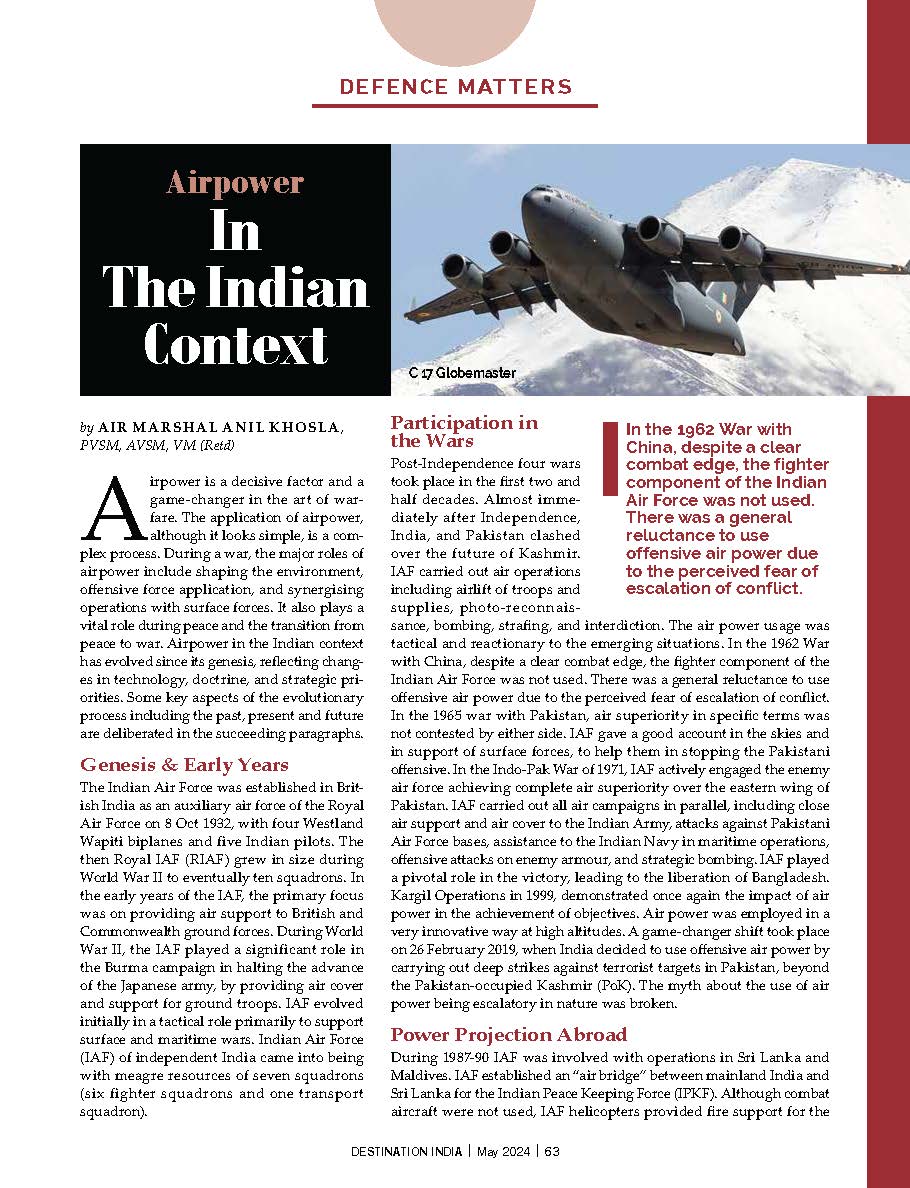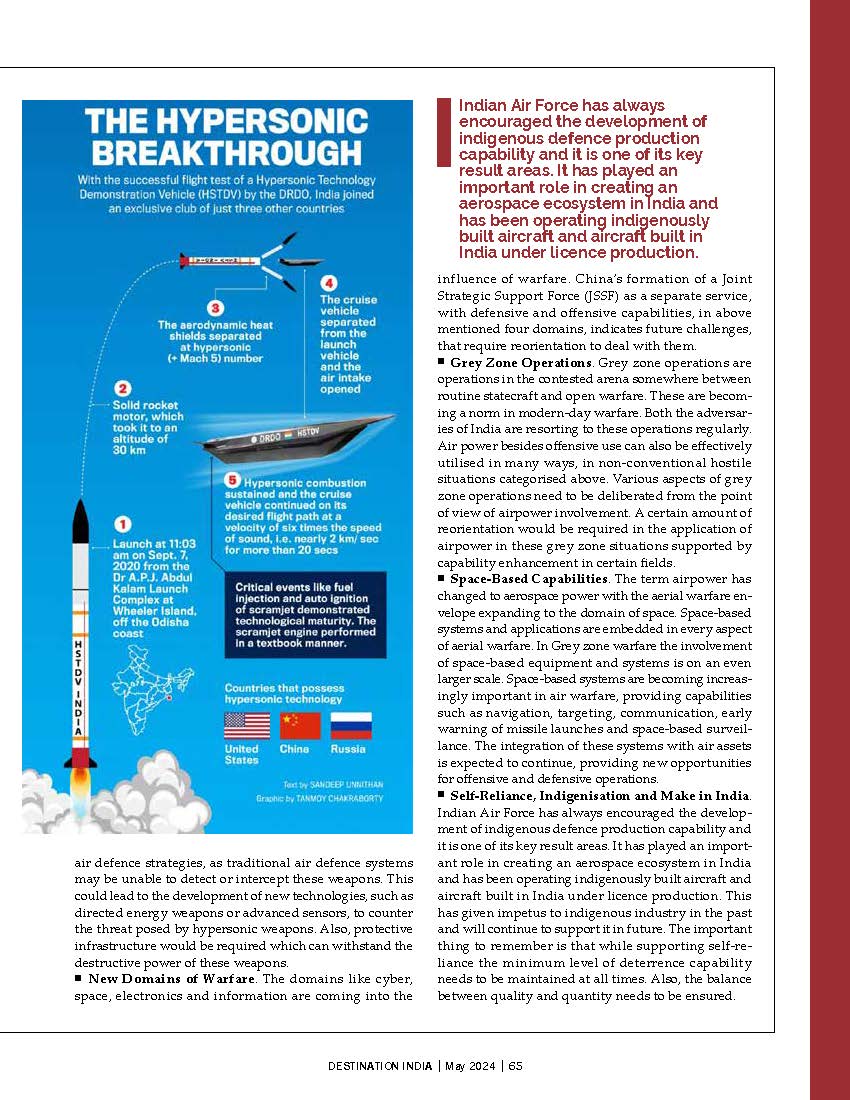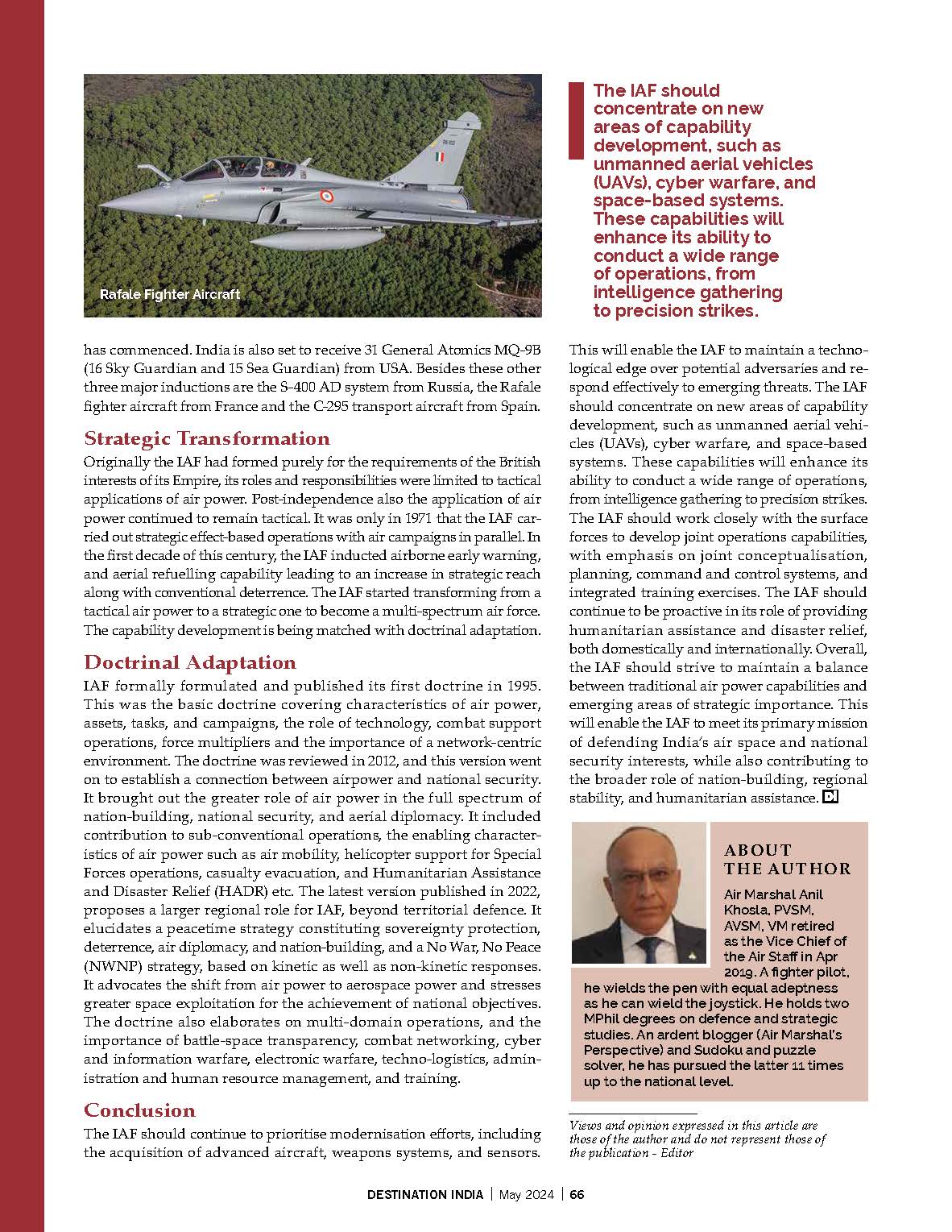 Pic Courtesy: Internet
Pic Courtesy: Internet
Shubhangi Palve is a Defence & Aerospace journalist currently associated with EurAsian Times. Prior to this role, she worked as a staff writer at ET Prime, focusing on defence strategies and the defence sector from a financial perspective. She has more than 15 years of extensive experience in the media industry, spanning print, electronic, and online domains.
Her article on
“Battle of A.I Fighter Jets: China Set to Challenge US Air Force In Aerial Warfare With Smart Air Combat AI”
was published on 20 May 2024 on “The EurAsian Times”.
(Besides the two quotes, the views of the author are her own)
“Battle of A.I Fighter Jets: China Set to Challenge US Air Force In Aerial Warfare With Smart Air Combat AI”
Picture this: An unmanned combat air squadron launches into hostile skies, guided not by human pilots but by the cold calculus of artificial intelligence. With lightning speed, the AI war manager assesses threats, devises intricate battle plans, and unleashes a blistering onslaught of precision strikes against enemy strongholds. Each manoeuvre executes with machine perfection as the AI mastermind adapts seamlessly to the ever-shifting tides of aerial combat.
But hold on, this isn’t Hollywood fiction…
Welcome to the new age of hybrid airpower!
The Race for AI Supremacy Takes To the Skies
In the high-stakes game of military one-upmanship, a new battlefront has emerged – the fusion of Artificial Intelligence (AI) with aerial combat systems.
China claims to have seized a potential edge, developing an “intelligent air combat AI” capable of making split-second tactical decisions and explaining its reasoning to human partners using an intelligent discourse of data visualisations and natural language.
This shatters the long-standing “black box” quandary that has handcuffed militaries – the inability of inscrutable AI systems to articulate the rationale behind their choices. Chinese researchers claim that their ground-breaking AI can engage in intelligent discourse, using words, data visualisations, and charts to illuminate why it issues specific flight instructions.
The Profound implications? An AI co-pilot can forge an unprecedented hybrid of linguistics between the domains of machine logic and human contextual intellect. Moreover, the Chinese team audaciously boasts that this symbiotic melding of abilities can achieve a staggering near-100% win rate in simulated aerial combat scenarios.
Meanwhile, the United States still grapples with the opaqueness of current AI architectures, a situation that underscores the importance of transparency and explainability in AI-driven systems. The US Air Force Secretary recently experienced the limitations of a “still-learning” AI controlling his F-16 flight, and its decision-making processes during potential weapon deployments remain obfuscated.
“Warfare, in general, and air warfare, in particular, is undergoing a dramatic change rapidly due to advanced technologies. Among these technologies, those with the greatest impact include Quantum, AI, Hypersonics, Stealth, Nano, Miniaturization, and Robotics. AI has a big potential for warfare applications,” Air Marshal Anil Khosla (Retd.), Vice Chief of the Air Staff (VCAS) of the Indian Air Force, told the EurAsian Times.
General Dynamics X-62 VISTA US Skyborg
After recently receiving a new look and modifications at the Ogden Air Logistics Complex, the NF-16D, known as VISTA (Variable stability In-flight Test Aircraft), they departed Hill Air Force Base, Utah, on Jan 30, 2019. This aircraft is the only one of its kind in the world and is the flagship of the United States Air Force Test Pilot School. This F-16 has been highly modified, allowing pilots to change the aircraft flight characteristics and stability to mimic that of other aircraft. (U.S. Air Force photo by Alex R. Lloyd).
US Armament with AI
In a bold move, the US has embarked on an ambitious endeavour dubbed ‘Replicator,’ designed to rapidly bolster its capabilities in the face of escalating competition, particularly from the People’s Republic of China.
The heart of Replicator lies in swiftly deploying thousands of autonomous systems, harnessing the power of AI, robotics, and cutting-edge technology. With a staggering budget of US$1 billion allocated by the Department of Defence, the Replicator program aims to construct a formidable fleet of compact, weaponised autonomous vehicles.
The Pentagon is abuzz with over 800 active military AI projects, from streamlining processes and evaluating threats to enhancing battlefield decision-making. Notable initiatives include the innovative “Loyal Wingman” program and the deployment of swarm drones like the formidable V-BAT aerial drone.
“The current trend in air combat platforms involves AI-based unmanned aircraft collaborating with manned aircraft, harnessing both advantages. This strategy is dubbed the ‘Loyal Wingman Concept.’ I call it the ‘Mother Goose Concept.’ All sixth-generation platform programs are striving toward this objective,” remarked Air Marshal Anil Khosla.
In a ground-breaking demonstration of its capabilities, the US Naval Forces Central Command’s (NAVCENT) Task Force 59 recently showcased its prowess by executing a successful attack on a simulated enemy target using live rockets, all orchestrated by an unmanned vessel. Experimental submarines, tanks, and ships have already been outfitted with AI capabilities to navigate and engage targets autonomously.
Furthermore, the US military has openly acknowledged its utilisation of AI and machine learning algorithms to identify potential targets for airstrikes in conflict zones such as Iraq, Syria, and Yemen. These sophisticated algorithms, developed under Project Maven—a collaborative effort between Google and the Pentagon—are carefully supervised by human operators to ensure precision and ethical use in target selection processes.
China’s Investment in AI
While the world closely monitored China’s economic resurgence and geopolitical ambitions, a powerful undercurrent has been gathering force – a concerted national drive to harness artificial intelligence as a potent force multiplier across all war-fighting domains.
Beijing has supercharged investments in robotics, swarming technologies, artificial intelligence (AI), and machine learning’s myriad militant applications.
Their landmark 2017 “New Generation AI Development Plan” plainly prioritises unmanned combat systems, and other advanced military innovations take centre stage, reflecting China’s strategic prioritisation of AI technologies.
According to a report titled ‘AI Weapons in China’s Military Innovation’ by Global China, Chinese military experts and strategists from institutions like the PLA’s Academy of Military Science, National Defence University, and the National University of Defence Technology foresee a future where AI and intelligent weaponry will assume increasingly pivotal roles, potentially even tipping the scales in future conflicts.
China’s Challenges US
China is now challenging its long-standing US dominance in aerial combat platforms as it surges ahead in investment, research, and development (R&D) across several ground-breaking technologies.
While US technology has evolved and been proven over the years, Chinese advancements are claimed and not demonstrated or proven. Notwithstanding, these claims cannot be taken lightly, according to Anil Khosla.
Furthermore, Anil Khosla emphasises that maintaining a lead in the technological race revolves around the defence market. Securing a foothold in the defence market holds immense appeal for economic and strategic considerations. On the financial front, it serves as a vital revenue stream and contributes to job creation. Strategically, it reduces the dependency of importing nations on external sources.
As this AI arms race intensifies, extending beyond just aviation to permeate all domains of warfare, the nation that unlocks the secret of harmonising machine intelligence with human cognition could seize an extraordinary strategic advantage. The theatre may be the skies, but the stakes could hardly be higher.
Keeping the Atomic Finger off AI Trigger
Back in the Cold War days, all eyes were on the nuclear arms race, a chilling competition that morphed into today’s reality of mass destruction weapon systems on the battlefield.
Fast forward to now, and the numbers are staggering: a whopping 12,500 nuclear warheads, with Russia and the US dominating possession, claiming nearly 90% of this terrifying arsenal.
A recent report from the Arms Control Association reveals the extent of nuclear stockpiles: Russia leads with 5,889 warheads, trailed closely by the US with 5,244, and China with 410.
Moreover, beyond the five permanent Security Council members—US, China, France, Russia, and the UK—other nations recognised under the nuclear non-proliferation treaty as nuclear-capable include Israel, India, Pakistan, and North Korea.
In a recent statement, US State Department arms control official Paul Dean underscored the importance of human control over nuclear decisions, emphasising that the US has unequivocally committed to ensuring that only human beings have the authority to deploy nuclear weapons.
This sentiment is echoed by the UK and France, who have pledged to keep nuclear control firmly in human hands, shunning the involvement of AI. Furthermore, the US has urged China and Russia to follow suit, urging them to prioritise human oversight in utilising these potent weapons rather than entrusting such decisions to artificial intelligence.
The AI Conundrum
In conclusion, integrating AI into military systems represents a significant leap forward in modern warfare. As highlighted by Anil Khosla, within novel systems that amalgamate multiple sensors and weapon systems into a unified framework. These systems must sift through vast amounts of data for analysis.
The fusion of AI and quantum computing enables this process to occur rapidly. When combined with miniaturisation, one obtains an optimal system for airborne platforms—small and lightweight yet possessing high computing power and speed. Integrating these technologies would give decision-makers swift decision-making tools, such as decision support systems and ‘what if’ option tools.
However, it is crucial to acknowledge AI’s inherent limitations, particularly in its current state. While AI excels at executing mundane tasks and analysing data patterns, its ability to make nuanced decisions remains questionable. This raises ethical and practical concerns, especially concerning lethal autonomous weapons (LAWs) equipped with AI.
The proliferation of LAWs, empowered by AI, sparks heated debates among experts, touching upon legality, ethics, and the potential for unintended consequences. While AI-enhanced drones may enhance military capabilities, they also introduce new risks and challenges that must be carefully considered.
As we navigate this AI conundrum, it is imperative to approach the integration of AI into military systems with caution and foresight. By striking a balance between technological advancement and ethical considerations, we can harness the potential of AI to enhance military capabilities while mitigating risks and safeguarding human interests. We can responsibly navigate AI’s complexities in modern warfare through thoughtful deliberation and collaboration.
My Comments on the subject:-
1. Warfare in general and air warfare in particular is undergoing a dramatic change rapidly due to advanced technologies.
2. Technologies with maximum effect are Quantum, AI, Hypersonics, Stealth, Nano, Miniaturisation, Robotics, etc.
3. AI has a big potential for warfare applications.
4. Firstly in unmanned autonomous platforms.
5. Unmanned platforms (Drones in airwarfare) are changing the air warfare in a revolutionary manner.
6. Second potential is in new systems which have multiple sensors and weapon systems integrated together. These systems have to analyse a large volume of data. AI and quantum computing combination can do that at a rapid rate. Couple them with miniaturisation and one gets an ideal system for Airborne platform (Small, light, high computing power and high computing speed).
7. The combination of these technologies would would provide the decision makers with quick decision making tools like decision support systems and what if option tools.
8. USA has been dominating the skies with creation of aerial combat platforms with advanced technology.
9. Now China is challenging their monopoly in this field as China is ahead in investment and R&D in some of these path breaking technologies.
10. USA is trying to retain it’s leadership position, while China is trying to catch up or race ahead.
11. USA technology has evolved and proven over the years. Chinese advancements are claimed and not demonstrated or proven. Not withstanding, these claims cannot be taken lightly.
12. Another reason for staying ahead in the technology race is the defence market. Capturing the defence market is highly desirable due to economic reasons (revenue source and job creation) and Strategic reasons (Dependency of importing countries).
13. The current trend in the air combat platforms is for AI based unmanned aircraft to work along with manned aircraft, reaping the benefits of both. It is called “Loyal Wingman Concept”. I call it mother goose Concept. All sixth generation platform programs are working towards it.
14. The trend of air warfare is towards “No contact warfare”, i.e. with long range vectors and unmanned aerial platforms.
15. In future the air wars would be fought by AI based unmanned platforms with smart weapons with minimal human intervention. – Scary thought.
Link to the Article at EurAsian Times:-
Suggestions and value additions are most welcome.
For regular updates, please register here:-
References and credits
To all the online sites and channels.
Disclaimer:
Information and data included in the blog are for educational & non-commercial purposes only and have been carefully adapted, excerpted, or edited from reliable and accurate sources. All copyrighted material belongs to respective owners and is provided only for wider dissemination.







